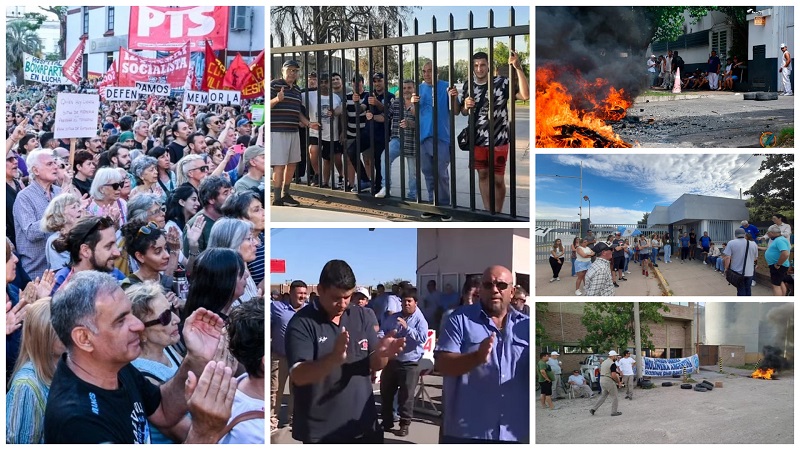
At the gate of Dass, the manufacturer of Adidas and Nike in Argentina, there is a very symbolic sign. “New year, new challenges”. But the businessman’s “motivational” message hid a slap in the face to the footwear workers, who on January 2 received a dismissal telegram. There are 360 telegrams in total, because the multinational announced its closure.
The method of surprise layoffs, between holidays, by WhatsApp, telegram or at the entry turnstile, was repeated by several companies. Others preferred to pay salaries in half.
Surely The bosses expected the workers to bow their heads and stay at home.. If the CGT has been sleeping since May, it is not going to wake up right now. They were wrong. In it Euro refrigerator (Gálvez) They picketed the door and the union and Governor Pullaro’s officials had to appear to dictate conciliation with the workers “inside.” In General Las Heras The meat workers got tired of being “rested” and gathered at the doors. The meat union arrived. A month ago they decided to occupy the company “to avoid emptying it.” In the Rawson Fishery (Chubut) They set up a camp against 11 dismissals and non-compliance with the company’s salaries. in electronics Radio Victoria They fired workers in the middle of the holidays and the internal commission took a forceful measure. They have already reinstated two but there is conciliation. The drivers of the 10 lines of Ideal San Justo They woke up on Monday next to their bonds, but they didn’t get on. Withholding of tasks until they deposit the wages owed. “We do not want to be hostages to the debate on subsidies vs. tariffs.” The lines that had been charged sympathized with those that had not. The workers of Lipo They became “super acidic” when they saw that 50% of their salary had been deposited. Not one more candy comes out. Arrest. In Bajo Hondo Floursnear Bahía Blanca, drip layoffs fed up with the millers. 96-hour strike, picket and conciliation “with the workers inside.” The Miller Union appeared. Also nearby, in Coronel Suárez, the workers of That They began to gather at the gates, they called the union, they went to the Municipality and the Buenos Aires Ministry of Labor had to intervene. The and the retired Street actions against the national government began on Wednesday. This Friday the Aerolíneas Argentinas pilots They reported that the conflict could be reopened if the government does not call joint negotiations soon. Also today the patients and workers of CEMEFIR (rehabilitation center) of La Matanza embraced against the closure. In Pilar, more than 80 “homeless” families from the Río Luján neighborhood resist the eviction attempt by Mayor Achával (UP).
This happened in 4 or 5 days.
There are some keys to summarize what is happening:
1. Continue the attack. 2025 was a turn in the almanac but the attack by Milei and the businessmen continues without pause. The deep debate is who pays for the recession and the crisis? Despite the data disseminated by the government, the war plan continues to be to lower real salaries, lay off workers to increase the exploitation of those who maintain their jobs, and attack living conditions (retirements, housing, dining rooms).
2. Junk work. The plan includes an increase in precariousness. As they denounce in Dass “they want to take the production to Misiones where they pay half.” The meat union says they fire “because they want to hire monotributistas.”
3. Mosca mata relato. As we analyzed in the notes we published last Sunday 5/1, no one can deny the adjustment but the resistance cannot be hidden either. The story of “not a fly flew in the face of a giant adjustment” is once again contradicted by harsh reality.
4. Those above debate. There is no such or such company affected. There is a deeper crisis as a result of the economic policies of the different governments, which with Milei has taken a leap with the fall in consumption, the industrial recession, the bet on financial capital and an attack on the main productive force, the working class. These contradictions have fueled a debate between capitalist sectors. Many demand policies that favor them: devaluation and differential dollars, closure of imports, subsidies, tax benefits, new special regimes. The debate often reaches the level of blackmail, with the workers as cannon fodder. This is what we see in many transportation or agribusiness companies.
5. Attentive bureaucracy. The CGT is erased, complicit in the adjustment. But many local unions have had to get moving. They hang their flags next to the gates. In some cases because the closures leave them without representation in entire regions. Furthermore, they know that it is preferable for them to take the lead in a negotiation before conflicts radicalize and “get out of hand.” The occupation of Textilcom by 100 workers was a wake-up call.
6. Lesser evil. The unions get involved in the debate of who pays for the crisis? but they do not face a serious fight for workers’ interests, which would mean affecting those of businessmen. In some cases they negotiate better compensation, in others fewer dismissals or exchange them for suspensions. There are branches where they openly align with requests for subsidies or trade policies (transportation, footwear, clothing, meat).
7. Phantom reconciliations. Provincial governments, whether Peronist or Cambiomita, limit themselves to settling conflicts or negotiating the same as union leadership. The main objective is to prevent any tough fight from infecting other sectors that suffer the same adjustment. Axel Kicillof’s Ministry of Labor has been transformed into a Ministry of Phantom Conciliation, where the employers do not respect the conditions or make maneuvers, but it always ends badly.
8. Denialist adjustment. These first conflicts of 2025 are not only in companies. The attack on the state officials of the Human Rights Secretariat and the memory spaces unleashed a conflict that already had a massive festival at the ESMA as its first response. There the demand for a “general strike” was heard again. Milei-Villaruel’s attack, which is part of his denialist policy, threatens to awaken a fight that could be a milestone in the resistance.
This quick point can serve to continue the debate about what happened in 2024 and how to organize a resistance that defeats Milei and her plan.
To The Daily Left Showing this “conflict” as no national media does is part of that political struggle.: it allows us to know what is happening, that each fighter is not alone, that there are others who stand up against the demoralizing visions of Peronism and the arrogant views of the right.
But it’s not just about spreading those fights, or supporting them separately. As we said in Milei’s balance of the year, “the experiences of 2024 They have to be a point of support for a resistance that necessarily has to take a leap, harden and coordinate. Fight together and seek to mature more and more a vanguard that hardens and draws conclusions from Each fight, beyond each partial battle, is part of continuing to organize and develop the resistance”.
The PTS and its classist groups are in that. We have a motto: let the big businessmen pay for the crisis. we have a way: unite and coordinate everyone who wants to resist, fight as hard as possible, as these conflicts are beginning to show. We have a program, a way out: no cuts, emergency increases in salaries and pensions; If production drops, reduce the working day and distribute the working hours without reducing wages; that dismissals and suspensions be prohibited by law; that employers show their numbers; If they close or lay off en masse, we must propose occupation and start-up under workers’ management, as thousands of workers did in the 2001 crisis.
The cry of “general strike” that was heard at ESMA may gain echo from the heat of the new sectors that resist and the persistence of those of us who have been fighting for years.
It’s them or us. Join the fight with the left and the combative sectors for this solution.
Source: www.laizquierdadiario.com

